Indian Society & Social Justice - 1 | Current Affairs & Hindu Analysis: Daily, Weekly & Monthly - UPSC PDF Download
Health Insurance for India’s Missing Middle
NITI Aayog has released a comprehensive report titled Health Insurance for India’s Missing Middle. It brings out the gaps in the health insurance coverage across the Indian population and offers solutions to address the situation.
- Health insurance is a mechanism of pooling the high level of Out of Pocket expenditure (OOPE) in India to provide greater financial protection against health shocks.
- India’s health sector is characterized by low Government expenditure on health, high out-of-pocket expenditure (OOPE), and low financial protection for adverse health events.
Who Constitute Missing Middle
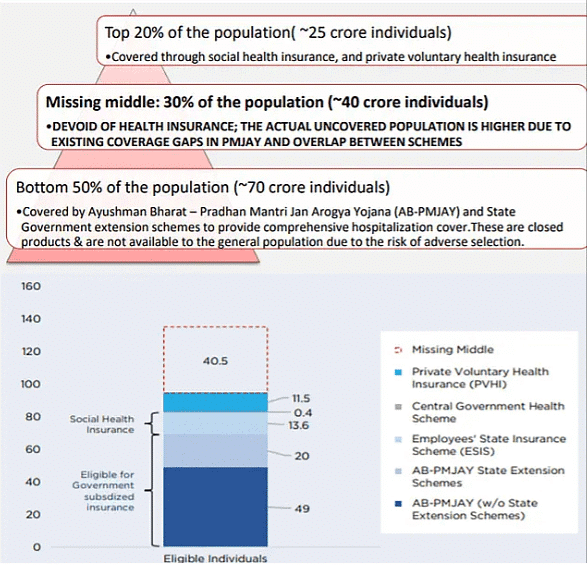
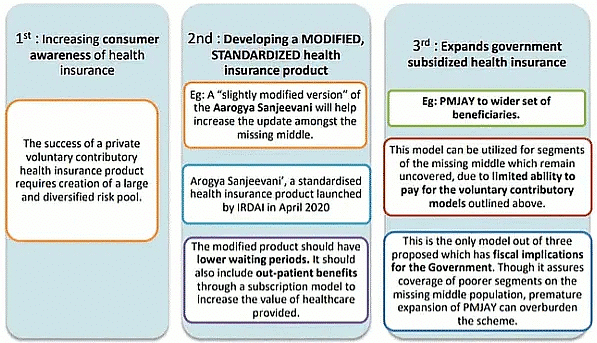
A combination of the three models, phased in at different times, can ensure coverage for the missing middle population
- Short-term: Focus should be on expanding private voluntary insurance through commercial insurers.
- Medium-term: once the supply-side and utilization of PMJAY and ESIC is strengthened, their infrastructure can be leveraged to allow voluntary contributions to a PMJAY plus product, or to ESIC’s existing medical benefits.
- Long-term: Once the low-cost voluntary contributory health insurance market is developed, expansion of PMJAY to the uncovered poorer segments of the missing middle should be considered.
- The report has also suggested sharing of the government scheme data with the private insurance companies. Government databases such as National Food Security Act (NFSA), Pradhan Mantri Suraksha Bima Yojana, or the Pradhan Mantri Kisan Samman Nidhi (PM-KISAN) for agricultural households can be shared with private insurers after taking consent from these households, the report said, suggesting an outreach strategy.
Bhasha Sangam Initiative
Ministry of Education launched Bhasha Sangam under Ek Bharat Shreshtha Bharat (EBSB) to commemorate Rashtriya Ekta Diwas.
- Ek Bharat Shreshtha Bharat was announced in 2015 on the occasion of the 140th birth anniversary of Sardar Vallabhbhai Patel under which every State and UT would be paired with another State/UT for a time period, during which they would carry out engagement with one another in the spheres of language, literature, cuisine, festivals, cultural events, tourism etc.
- Bhasha Sangam is to teach basic sentences of everyday usage in 22 Indian languages. The idea is that people should acquire basic conversational skills in an Indian language other than their mother tongue. It is amined that at least 75 lakh people should acquire this skill during the Azadi Ka Amrit Mahotsav period. Initiatives launched under Bhasha Sangam
 Safaimitra Suraksha Challenge
Safaimitra Suraksha Challenge
Recently, the Ministry of Housing and Urban Affairs (MoHUA) has launched a week-long awareness campaign on SafaiMitra Suraksha Challenge (SSC) as part of the ‘World Toilet Day’ (19th November) celebrations, to run up to the ‘Swachh Amrit Diwas’. Ministry of Housing and Urban Affairs (MoHUA) launched Safaimitra Suraksha Challenge (SSC) on the occasion of World Toilet Day (19th November 2020). SSC has main objective of eradicating the practice of hazardous cleaning of sewers and septic tanks and promote mechanized cleaning of the same.
Important Features of SSC
- Total 246 cities are going to participate in the challenge. The state capitals, urban local bodies and smart cities will be eligible to participate. -
- SSC is aimed to encourage cities to mechanize their sewer and septic tank cleaning operations in order to prevent deaths and fatalities of sanitation workers from ‘hazardous entry’. -
- The initiative is in line with the core of the Swachh Bharat Mission-Urban (SBM-U)
Components of Safaimitra Suraksha Challenge
- Skill Development Trainings of Safaimitras have been conducted through the support of the Ministry of Social Justice and Empowerment. It will also include ‘Recognition of prior learning’ (RPL) model for Green jobs.
- Under SSC, National Safai Karamcharis Finance & Development Corporation (NSKFDC), Ministry of Social Justice and Empowerment, supported by MoHUA are organizing Loan Melas across the country.
- All 246 participating cities have already notified ban on single-use plastic (SUP)
- Separate Standard uniform designs for different categories of sanitation workers across urban India. It will include :
- Assessment by independent third party.
- Cities can try to implement innovative solutions for this like Bandicoot robot deployed by Kerala government for cleaning of sewer.
- 31 states/UTs have established a Responsible Sanitation Authority (RSA) and 210 cities are having the Sanitation Response Units (SRU) 8. A dedicated helpline number has been set up to register complaints and provide real-time solutions on desludging or sewer overflow.
- Cities being awarded a cash prize based on their performance.
- Swachhata Commandos (sanitation workers engaged in underground cleaning of sewers and septic tanks
- Safaimitras (engaged in road sweeping and waste collection.
- Swachhata Supervisors/ Operators
Need of Safaimitra Suraksha Challenge
- Supreme court through different judgements prohibited hazardous cleaning, i.e. manual entry into a septic tank or sewer without protective gear and observing operating procedures.
- Same provision is there under The Prohibition of Employment as Manual Scavengers and their Rehabilitation Act (2013).
- Still this practice is prevalent in municipalities across India. There are instances of death of manual scavengers in Delhi, Hyderabad, Mumbai.
- As per SECC, 2011 there are 180000 manual scavengers in India.
- SSC stresses on the fact that safety and dignity of sanitation workers is the core of Swachh Bharat Mission.
- Hence such kind of challenges will bring together all stakeholders to curb this inhuman practice and ensure cleanliness through technology interventions.
Legal Metrology Rules 2011 Amended
- Centre has amended the Legal Metrology (Packaged Commodities) Rules 2011 to protect the interest of consumers (January 2021). Rules are being made under Legal Metrology Act 2009.
- Legal metrology is the application of legal requirements to measurements and measuring instruments. Important examples are Medicines, pre-package food items, medical devices like oxygen support devices in COVID-19 times are comes under ambit of legal metrology for description rules and regulations.
Provisions Under Legal Metrology (Packaged Commodities) Rules 2011
- The objective of Legal Metrology is to ensure public guarantee from the point of view of security and accuracy of the weighments and measurements.
- The act provides for application of legal requirements to measurements and measuring instruments.
- The Department of Consumer Affairs, administers the Legal Metrology Act 2009.
- Rules are primarily intended to ensure that the consumers are able to make informed choices by being informed of essential declarations on the pre-packed commodities.
Recent Amendments
- The Department of Consumer Affairs has omitted the Rule 5 of the Legal Metrology (Packaged Commodities), Rules 2011 to safeguard interest of consumers. Rule 5 defines the Schedule II prescribing the pack sizes of various types of commodities.
- Companies selling packaged commodities with a quantity of more than one kilogram are required to print ‘unit sale price’ per kg along with its maximum retail price (MRP).
- Rule regarding mentioning of quantity on a packaged commodity was amended. Now the quantities can be expressed in terms of the number or unit or piece or pair or set or such other word which represents the quantity in the package. Earlier Quantity should either be in ‘number’ or ‘unit’ and it should be mentioned as “xxN or xxU ''.
- Date declaration has now been required to the month and year in which the pre packed commodity is manufactured.
- The provisions of declarations of MRP have been simplified by removing illustration and providing for making the mandatory declaration of MRP in Indian currency inclusive of all taxes.
With Changes, Following Positive Implications for Customers
- It will be easier for consumers to find the cost in unit terms which will help for conscious purchase decisions.
- It will lessen compliance burden on industries.
- Easier for domestic customers who are using internationally produced goods.
- These amendments will ensure transparency and accountability in the pre-packaged goods market.
Multidimensional Poverty Index
Multidimensional poverty index seeks to measure poverty across multiple dimensions in country. It is to quantify poverty in all of its forms. NITI Aayog has released first national multidimensional poverty index.
- First national multidimensional poverty index shows that 25% of India’s population is poor. The figure is higher than income based measures of poverty.
- The MPI released by Niti Ayog used data from 4 th National Family Health Survey 2015-16.
The index used three equally weighted dimensions of Health, education and standard of living. It has used 12 indicators like nutrition, sanitation and a housing bank account.
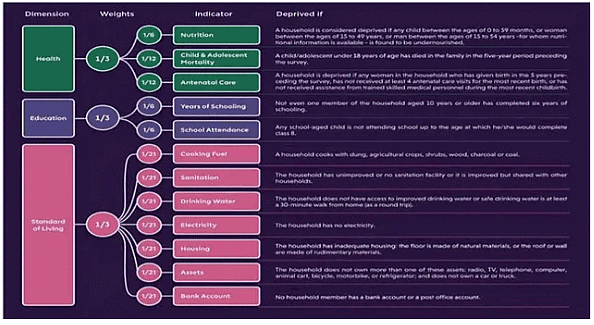 Salient Feature of Index
Salient Feature of Index
- The index is first ever country’s own poverty index.
- To track poverty across subnational regions
- It can be used to deconstruct Global MPI and to improve India’s ranking in global position.
- It will complement monetary poverty reduction efforts.
- It provides ample of data to help policy maker to make effective decision. This report delves in to in-depth analysis of the head count ratio and intensity of multidimensional poverty at the national, state and district levels.
Purpose: National Multi Poverty index is tailored to national priorities. It has break down by sub national regions, urban or rural areas, age and other factors.
Key Findings
- Bihar has the highest proportion of poor people. It is followed by Jharkhand and then Uttar Pradesh.
- Kerala has lowest number of poor people followed by Goa and Sikkim

- Bihar has also highest number of malnourished people. It is followed by Jharkhand, Madhya Pradesh, Uttar Pradesh and Chhattisgarh.
- Pondicherry has least poor people among union territories. It is being followed by Lakshadweep. National capital is performing low on maternal health index. It weighted only 15.9%.
- Uttar Pradesh performed worst on child mortality rate with 4.97%.
- Manipur has highest number of people deprived of drinking water.
- Jammu and Kashmir has highest number of people with bank account.
Methodology: Used the globally accepted and robust methodology developed by Oxford Poverty and Human Development Initiative (OPHI) and United National Development Programme (UNDP).
National Family Health Survey (NFHS)- 5
National Family Health Survey 5 is the recent round of the survey carried on by Ministry of Health and Family Welfare (MoH&FW) to bring out reliable data on emerging health and family welfare issues. International Institute for Population Sciences, Mumbai and Population Research Centres are the coordinating and implementing agencies that helped to bring out this NFHS round. ICF International, a global consulting and technology services company, provided technical assistance for the NFHS 5 while the United States Agency for International Development provided financial assistance.
Important Findings
- The NFHS provides estimates on key indicators related to population, family planning, child and maternal health, nutrition, adult health, and domestic violence, among others.
- The biggest positive headline news from NFHS-5 is that the total fertility rate (TFR), which is the average number of children born to a woman during her lifetime, has been falling over time and is now just below the replacement rate of 2.1.

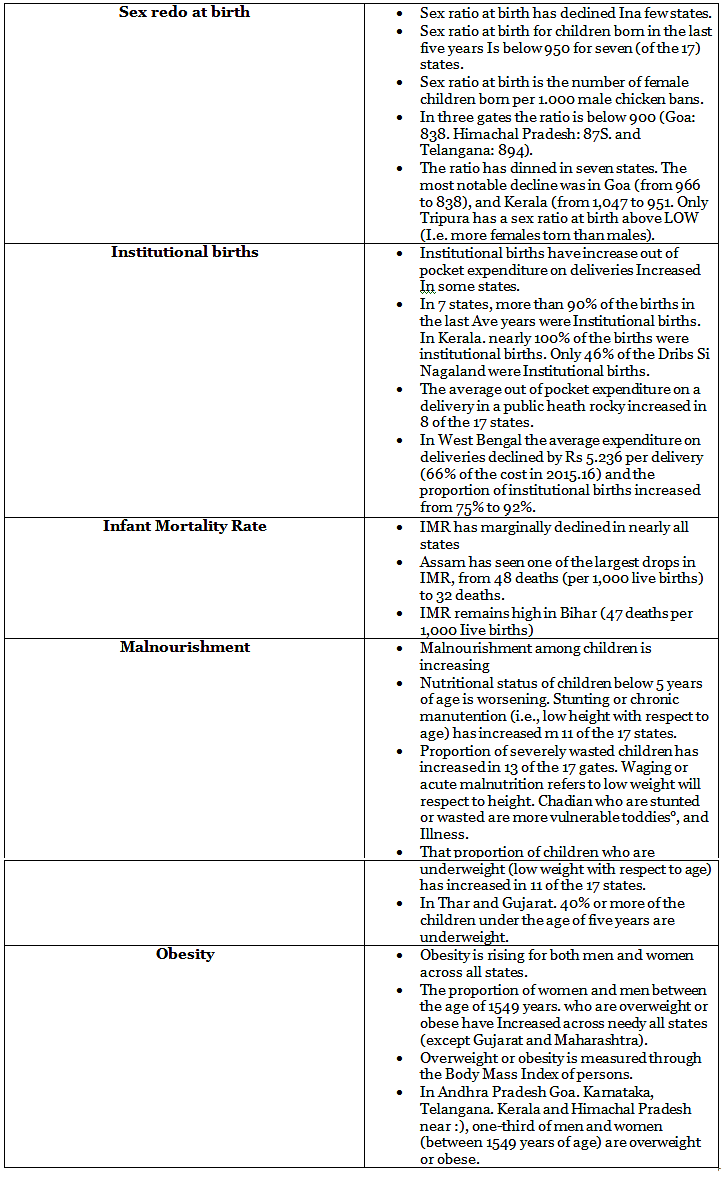 Low Life Expectancy Among Urban Poor
Low Life Expectancy Among Urban Poor
‘Health Care Equity in Urban India’- a report released by Azim Premji University explored health vulnerabilities and inequalities in cities in India. It also looked at the availability, accessibility and cost of healthcare facilities, and possibilities in future-proofing services in the next decade.
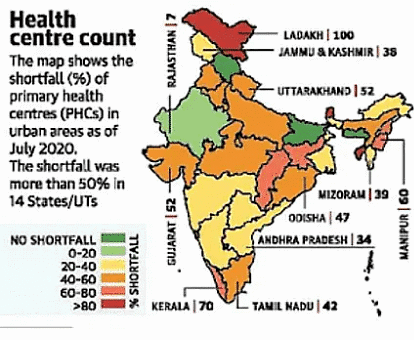
Findings
- Life expectancy among the poorest is lower by 9.1 years and 6.2 years among men and women, respectively, compared to the richest in urban areas.
- Multiplicity of healthcare providers both within and outside the government who work without coordination leading to chaotic urban health governance.
- Heavy financial burden on the poor, and less investment in healthcare by urban local bodies.
- Urban healthcare has received relatively less research and policy attention.
Way Forward
- Strengthening governance community.
- Building a comprehensive and dynamic database on the health and nutrition status, including comorbidities of the diverse, vulnerable populations.
- Strengthening healthcare provisioning through the National Urban Health Mission, especially for primary healthcare services.
- Putting in place policy measures to reduce the financial burden on the poor.
- Better mechanism for coordinated public healthcare services and better governed private healthcare institutions.
Conclusion
A well-functioning, better coordinated and governed health care system is crucial at this point. The pandemic has brought to attention the need for a robust and resourced healthcare system. Addressing this now will benefit the most vulnerable and offer critical services to city dwellers across income groups.
Covid-19 & Adverse Impact of School Closure
According to UNESCO, school closures carry high social and economic costs for people across communities. Their impact, however, is particularly severe for the most vulnerable and marginalized children and their families. Educational disruption due to prolonged closure of schools across the globe will not only have alarming effects on learning loss but also poses threat to gender equality. The resulting disruptions exacerbate already existing disparities within the education system but also in other aspects of their lives.
These Include
- Interrupted learning: Schooling provides essential learning and when schools close, children and youth are deprived opportunities for growth and development. The disadvantages are disproportionate for under-privileged learners who tend to have fewer educational opportunities beyond school.
- Poor nutrition: Many children and youth rely on free or discounted meals provided at schools for food and healthy nutrition. When schools close, nutrition is compromised.
- Confusion and stress for teachers: When schools close, especially unexpectedly and for unknown durations, teachers are often unsure of their obligations and how to maintain connections with students to support learning. Transitions to distance learning platforms tend to be messy and frustrating, even in the best circumstances. In many contexts, school closures lead to separation from teachers.
- Parents unprepared for distance and home schooling: When schools close, parents are often asked to facilitate the learning of children at home and can struggle to perform this task. This is especially true for parents with limited education and resources.
- Challenges creating, maintaining, and improving distance learning: Demand for distance learning skyrockets when schools close and often overwhelms existing portals to remote education. Moving learning from classrooms to homes at scale and in a hurry presents enormous challenges, both human and technical.
- Gaps in childcare: In the absence of alternative options, working parents often leave children alone when schools close and this can lead to risky behaviours, including increased influence of peer pressure and substance abuse.
- High economic costs: Working parents are more likely to miss work when schools close to take care of their children. This results in wage loss and tend to negatively impact productivity.
- Unintended strain on health-care systems: Healthcare workers with children cannot easily attend work because of childcare obligations that result from school closures. This means that many medical professionals are not at the facilities where they are most needed during a health crisis.
- Rise in dropout rates: It is a challenge to ensure children and youth return and stay in school when schools reopen after closures. This is especially true of protracted closures and when economic shocks place pressure on children to work and generate income for financially distressed families.
- Increased exposure to violence and exploitation: When schools shut down, early marriages increase, more children are recruited into militias, sexual exploitation of girls and young women rises, teenage pregnancies become more common, and child labour grows.
- Social isolation: Schools are hubs of social activity and human interaction. When schools close, many children and youth miss out on social contact that is essential to learning and development.
- Challenges measuring and validating learning: Calendared assessments, examinations that notably determine high-stakes admission or advancement to new education levels and institutions, are thrown into disarray when schools close. Strategies to postpone, skip or administer examinations at a distance raise serious concerns about fairness, especially when access to learning becomes variable. Disruptions to assessments result in stress for students and their families and can trigger disengagement.
National Health Accounts
Union Ministry of Health and Family Welfare released findings of National Health Accounts (NHA) estimates for 2017-18. This is the 5th consecutive NHA report produced by National Health Systems Resource Centre (NHSRC). The NHA estimates are prepared by using an accounting framework based on internationally accepted System of Health Accounts, 2011, provided by WHO.
Findings of 2017-18 National Health Accounts
- Increasing public health expenditure: There has been an increase in the share of government health expenditure in the total GDP of the country. Public health expenditure has increased from 1.15% of GDP in 2013-14 to 1.35% in 2017-18.
- Share of government health expenditure in total health expenditure has also increased overtime. In 2017-18, the share of government expenditure was 40.8%, which is much higher than 28.6% in 2013-14.
- Government's health expenditure as a share of total Government expenditure has increased from 3.78% to 5.12% between 2013-14 and 2017-18, clearly indicating Government's priority for the health sector.
- In per capita terms, government health expenditure has increased from Rs 1042 to Rs 1753 between 201314 to 2017-18. More emphasis on primary healthcare: The share of primary healthcare in total government health expenditure has increased from 51.1% in 2013-14 to 54.7% in 2017-18. Expenditure on primary and secondary healthcare accounts for 80% of Government health expenditure.
- In the private sector, the share of tertiary care has increased but primary and secondary care show a declining trend. Between 2016-17 and 2017-18 in government the share of primary and secondary care has increased from 75% to 86%. In private sector, the share of primary and secondary care has declined from 84% to 74%.
- The share of social security expenditure on health, which includes social health insurance program, Government financed health insurance schemes, and medical reimbursements made to Government employees, has increased. As a percent of total health expenditure, the increase is from 6% in 2013-14 to around 9 % in 2017-18.
- Declining out-of-pocket-expenditure (OOPE): Out-of-pocket-expenditure as a share of total health expenditure has come down to 48.8% in 2017-18 from 64.2% in 2013-14.
- On the per-capita basis, OOPE has declined from Rs 2336 to Rs 2097 between 2013-14 and 2017-18. One of the factors attributing to this decline is the increased utilisation and reduction in cost of services in government health facilities. If we compare NHA 2014-15 and 2017-18 there has been a decline in OOPE for government hospitals in the tune of 50%.
Recognition of Transgender
Persons in Indian Prisons Recently, the Union Home Ministry sent an advisory to Heads of Prisons in the States/UTs to ensure privacy, dignity of the third gender inmates.
- According to a National Crime Records Bureau, there were 70 transgender prisoners in jails across the country in 2020.
- The advisory was issued in light of the Transgender Persons (Protection of Rights) Act, 2019, which came into effect from January 2020. Key Points
- Infrastructure in Prisons: Separate enclosures or wards and separate toilets and shower facilities for transmen and transwomen to preserve the right to privacy and dignity of the inmates.
- Respect Self-identity: The self-identity of transgender persons must be respected at all times while conducting admission procedures, medical examination, frisking, clothing, requisitioning of a police escort, treatment and care inside prisons. Prisons to facilitate the process of acquiring the transgender identity certificate under the transgender persons law if such a request is made.
- Search Protocol: Searches should be carried out by a person of their preferred gender or by a trained medical professional or a paramedic trained in conducting searches. The person conducting the search must ensure the safety, privacy and dignity of the person being searched.
- Admission in Prison: The prison admission register may be suitably revised to include “transgender” as a category other than male and female gender. A similar provision may be made in the Prison Management System in maintaining electronic records.
- Access to Healthcare: Transgender inmates should have equal right to healthcare, without any discrimination on grounds of their gender identity.
- Communication with outside World: They must be allowed an opportunity to interact with their family members, relatives, friends and legal advisers and after-care planning by probation, welfare or rehabilitation officers.
- Training and Sensitisation of Prison Personnel: It should be done for developing an understanding of gender identity, human rights, sexual orientation and legal frameworks for transgender persons. Similar awareness must also be spread among other prisoners. Major Initiatives Related to Transgender
- Transgender Persons Act, 2019: The Act defines a transgender person as one whose gender does not match the gender assigned at birth. It includes transmen and trans-women, persons with intersex variations, gender-queers, and persons with socio-cultural identities, such as kinnar and hijra
- Judgements of the Supreme Court: National Legal Services Authority (NALSA) v. Union of India, 2014: The SC declared transgender people to be a ‘third gender’. Read down the Provisions of Section 377 of the Indian Penal Code (2018): The SC decriminalised same-sex relationships.
- Transgender Persons (Protection of Rights) Rules, 2020: The Central Government made the rules under the powers conferred by the Transgender Persons (Protection of Rights) Act, 2019. National Portal for Transgender Persons was launched under in consonance with the Transgender Persons (Protection of Rights) Rules, 2020.
- Scheme of ‘Shelter Home for Transgender Persons: To provide safe and secure shelter to transgender persons in need, the Ministry of Social Justice and Empowerment is setting up ‘Garima Greh’ shelter homes for them. Prisons Act and Transpersons
- In India, the Prisons Act, 1894, is the central legislation regulating the administration of prisons.
- The Act majorly differentiates prisoners convicted under civil law from those convicted under criminal law.
- Unfortunately, the Act does not even recognise sexual minorities based on Sexual Orientation and Gender Identity (SOGI) as a different class of prisoners.
- It only separates prisoners into the categories of women, young offenders, undertrials, convicts, civil prisoners, detenues and high-security prisoners.
- The NALSA judgment, while extending constitutional protection to trans persons under Articles 14, 15, and 21, directs states to make policies on their legal and socio-economic rights.
- This extends to trans prisoners as well, since prisons and their administration is a state subject.
- Even though the directions given in the NALSA judgment constitute the law of the land, there is still a requirement to bring forth changes in the present laws.
- The Prisons Act, however, allows the prison authorities to follow procedures that are strictly gender-binary.
- These procedures not only challenge the validity of the legislation but also result in a kind of torture and degrading treatment being inflicted upon trans people inside prisons.
- All of this is substantiated by a report titled ‘Lost Identity: Transgender Persons Inside Indian Prisons‘ by the Commonwealth Human Rights Initiative (CHRI). This report sheds light on issues faced by Transgender persons confined in Indian prisons.
Faecal Sludge and Septage Management
According to the NITI Aayog report Faecal sludge and septage management in urban areas, Service and business models, by 2021 more than 700 cities/towns are in various stages of Faecal Sludge and Septage Management (FSSM) implementation.
Key Points
- Faecal Sludge and Septage Management (FSSM).
About
- India has recognized the gaps in sanitation coverage and embarked purposefully to address them, becoming one of the first countries to announce a national policy on FSSM in 2017.
- FSSM prioritizes human excreta management, a waste stream with the highest potential for spreading diseases.
- It is a low-cost and easily scalable sanitation solution that focuses on safe collection, transportation, treatment, and reuse of human waste.
- As a result, FSSM promises a means to achieve the Sustainable Development Goals (SDG) target 6.2 of adequate and inclusive sanitation for all in a time bound manner. Related Initiatives:
- India has continued to show its commitment towards FSSM through the launch of Open Defecation-Free (ODF) + and ODF++ protocols, an emphasis on FSSM in Swachh Survekshan, as well as financial allocations for FSSM across
- Capacity of India’s Sewage Treatment Plants: According to the latest report of the Central Pollution Control Board (CPCB), Sewage Treatment Plants (STPs) in India are able to treat a little more than a third of the sewage generated per day. India generated 72,368 MLD (million litres per day) whereas the installed capacity of STPs was 31,841 MLD (43.9%). 5 states and Union Territories (UT) - Maharashtra, Gujarat, Uttar Pradesh, Delhi and Karnataka - account for 60% of the total installed treatment capacity of the country.
- Issues with Solid Waste Management: Absence of segregation of waste at source. Lack of funds for waste management at Urban Local Bodies (ULB). Lack of technical expertise and appropriate institutional arrangement. Unwillingness of ULBs to introduce proper collection, segregation, transportation and treatment/disposal systems. Indifference of citizens towards waste management due to lack of awareness. Lack of community participation towards waste management and hygienic conditions.

Prohibition Laws and Issues
Recently, the Bihar Government has decided to use Drones to monitor illegal liquor manufacturing. This has initiated the debate of the utility of using physical and financial resources to implement the provisions of the prohibition act.
Key Points - About
- Prohibition is the act or practice of forbidding something by law; more particularly the term refers to the banning of the manufacture, storage (whether in barrels or in bottles), transportation, sale, possession, and consumption of alcoholic beverages.
- Constitutional Provisions: Article 47 The Directive Principle in the Constitution of India states that “The state shall undertake rules to bring about prohibition of the consumption except for medicinal purposes of intoxicating drinks and of drugs which are injurious to health”.
- State Subject: Alcohol is a subject in the State list under the seventh schedule of the Indian Constitution.
- Other Prohibition Acts in India: Bombay Abkari Act, 1878: The first hint at the prohibition of liquor was through the Bombay Abkari Act, 1878 (in the Province of Bombay). This Act dealt with levying of duties on intoxicants, among other things and aspects of prohibition via amendments made in 1939 and 1947.
- Bombay Prohibition Act, 1949: There were “many lacuna” in the Bombay Abkari Act, 1878, from the point of view of the government’s decision to enforce prohibition. This led to the birth of Bombay Prohibition Act, 1949. The Supreme Court(SC) upheld the Act broadly barring a few sections in 1951 in the judgment of State of Bombay and another versus FN Balsara.
- Gujarat Prohibition Act, 1949: Gujarat adopted the prohibition policy in 1960 and subsequently chose to enforce it with greater rigidity, but also made processes easier for foreign tourists and visitors to get liquor permits. In 2011, the Act was renamed as Gujarat Prohibition Act. In 2017, the Gujarat Prohibition (Amendment) Act was passed with provision of up to ten years jail for manufacturing, purchase, sale and transportation of liquor in the dry state.
- Bihar Prohibition Act, 2016: The Bihar Prohibition and Excise Act was brought into effect in 2016. Over 3.5 lakh people have been arrested under the stringent prohibition law since 2016 leading to crowded jails and clogged courts.
- Other States: Alcohol prohibition in India is in force in the states of Mizoram, Nagaland as well as in the union territory of Lakshadweep Arguments against Prohibition of Liquor: The Right of Privacy: Any invasion by the state in an individual’s right to choice of food and beverage amounts to an unreasonable restriction and destroys the individual’s decisional and bodily autonomy. Right to privacy has been held as a fundamental right by the Supreme Court in several judgments since 2017.
- Aggravate the Sense of Violence: Various research and studies have shown that alcohol tends to aggravate the sense of violence. Most of the domestic violence crimes against women and children are committed behind closed doors.
- Loss of Revenue: Tax revenues from alcohol is a major part of any government’s revenues. These enable the government to finance several public welfare schemes. Absence of these revenues may severely impacts state’s ability to run public welfare programmes.
- Source of Employment: Today, the Indian Made Foreign Liquors (IMFL) industry contributes over 1 lakh crore in taxes every year. It supports the livelihood of lakhs of farming families and provides direct and indirect employment to lakhs of workers employed in the industry.
- Arguments in Favour of Liquor Prohibition: Impact on Livelihoods: Alcohol denudes family resources and reserves and leaves women and children as its most vulnerable victims. A social stigma at least as far as the family unit is concerned is still attached to the consumption of alcohol.
- Discourage Regular Consumption: Strict state regulation is imperative to discourage regular and excessive consumption of alcohol. As the prohibition is mentioned in the State List under Schedule Seven, it is the duty of the state to make provisions related to prohibition.
|
38 videos|5288 docs|1117 tests
|
FAQs on Indian Society & Social Justice - 1 - Current Affairs & Hindu Analysis: Daily, Weekly & Monthly - UPSC
| 1. What is the Bhasha Sangam Initiative? |  |
| 2. What is the Safaimitra Suraksha Challenge? |  |
| 3. What are the Legal Metrology Rules 2011? |  |
| 4. What is the Multidimensional Poverty Index? |  |
| 5. What is the National Family Health Survey (NFHS)- 5? |  |
















